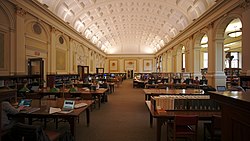Carnegie Library of Pittsburgh
 |
|

Interior view of the main branch in the Oakland neighborhood
|
|
| Established | February 6, 1890 |
|---|---|
| Location | Pittsburgh, Pennsylvania |
| Coordinates | 40°26′34″N 79°57′03″W / 40.442728°N 79.950787°WCoordinates: 40°26′34″N 79°57′03″W / 40.442728°N 79.950787°W |
| Collection | |
| Size | 5,230,200 |
| Access and use | |
| Circulation | 3,529,379 |
| Population served | 2,600,000 |
| Members | 294,733 |
| Other information | |
| Budget | $26,879,454 |
| Website | www |

Carnegie Library of Pittsburgh Main Branch in the city's Oakland neighborhood
|
|
| Location | 4400 Forbes Ave., Pittsburgh, Pennsylvania |
| Area | 9.5 acres (3.8 ha) |
| NRHP Reference # | 79002158 |
| Significant dates | |
| Added to NRHP | March 30, 1979 |
| Designated PHLF | 1970 |
The Carnegie Library of Pittsburgh is the public library system in Pittsburgh, Pennsylvania. Its main branch is located in the Oakland neighborhood of Pittsburgh, and it has 19 branch locations throughout the city. Like hundreds of other Carnegie libraries, the construction of the main library, which opened in 1895, and several neighborhood branches, was funded by industrialist Andrew Carnegie.
The Pittsburgh Photographic Library is a photography repository held by the Carnegie Library of Pittsburgh of over 50,000 prints and negatives relating to history of Pittsburgh.
The City of Pittsburgh was originally home to eight Carnegie libraries constructed at the turn of the 20th century. In 1881, Andrew Carnegie offered a US$250,000 grant to the city for the construction of a public library on the condition that the city provided the land and annual funding for the maintenance of the property. The city declined Carnegie’s initial offer out of concern that a publicly funded library was not a state-sanctioned use of public tax funds. With the passing of several years and the state legislature’s endorsement of the project, however, the city reconsidered the offer and reached out to Carnegie in the interest of accepting his grant.
In 1890, the City of Pittsburgh accepted an expanded grant of $1 million for the building of the main library in Oakland and five branches in the neighborhoods of Lawrenceville, West End, Wylie Avenue (Hill District), Mount Washington, and Hazelwood. While the initial plan only called for those five branches, the Pittsburgh would go on to receive another three Carnegie libraries in the East Liberty, South Side, and Homewood neighborhoods. Construction on the main library was finished in 1895 while the branch libraries were constructed over the following fifteen years, ending with the completion of the Homewood branch in 1910.
...
Wikipedia



